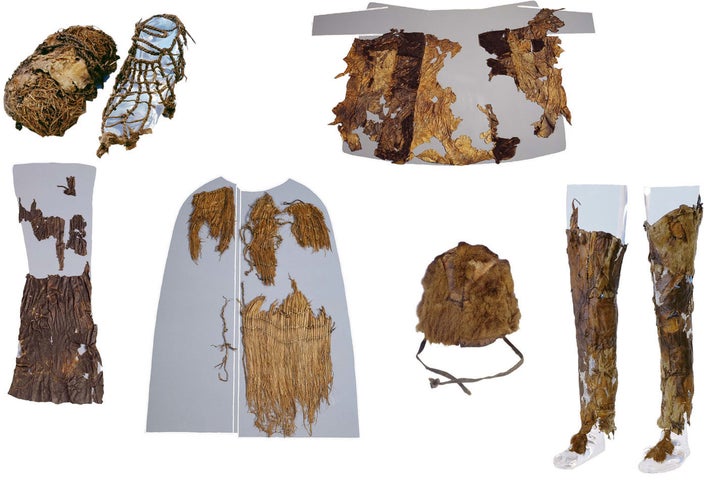
Since the discovery of Ötzi the Iceman in a European glacier in 1991, scientists have recovered a wealth of information from his 5,300-year-old mummified remains: The brown-eyed, gap-toothed, tattooed man most likely spent his 40-odd years farming and herding, and was probably suffering from a painful stomach ache at the time that he died a quick—albeit violent—death in the Öztal Alps.
After 25 years of extensive scientific research and media coverage, the Neolithic Iceman has certainly secured his place as “Europe’s Oldest Celebrity.” However, only now are we getting a detailed answer to the inevitable question posed to every celebrity these days:
“Ötzi, who are you wearing?”
Why Clothing Counts
The Iceman was recovered back in 1991 with a full assortment of clothing, including a hide coat, skin leggings, fur hat, and hay-stuffed shoes. Due to the decomposition of the leather and fur over thousands of years, however, researchers have been unable to conclusively pinpoint specific animal species for some of the components of Ötzi’s wardrobe.
Understanding the choice of animals used in ancient clothing production—domestic or wild, local or imported—provides unique insights into the human past: Was the clothing worn purely for utility, or did it reflect the social status of the wearer? Were animal skins selected solely due to their availability, or were certain types of leathers and furs prized for specific qualities?
A Coat of Many Skins
Researchers were able to capture ancient DNA markers in nine samples of leather and fur from different articles of the Iceman’s clothing. According to their study published today in Scientific Reports, Ötzi’s attire choices were selective and pragmatic.
They confirmed that Ötzi’s leather loincloth and hide coat were “haphazardly” stitched from sheepskin, an identification already made in previous studies. However, the genetic analysis revealed that the sheep species sampled is closer to modern domestic European sheep than to their wild cousins, and that the articles were fashioned from the skins of at least four animals.
The analysis showed that part of Ötzi’s coat was also made from domesticated goat belonging to a mitochondrial haplogroup (a genetic population that shares a common female ancestor) that still roams the hills and valleys of central Europe today.

Neolithic Style: Locally Sourced
The fact that the coat was made from at least several animals belonging to at least two different species leads the researchers to conclude that the Iceman’s coat was stitched together, and possibly repaired with, any hides that were handy at the time.
On the other hand, Ötzi’s leggings were also crafted from domesticated goat leather, and not a species of wolf, fox or dog as previously thought. The fact that a similar pair of 6,500-year-old leggings discovered in Switzerland were also fashioned from goat leather suggests that it may have been a material deliberately chosen for its specific qualities.
“While Ötzi likely lived a life of farming and herding, he may have also hunted and trapped wild animals in his alpine environment.”
Shoelaces fashioned from the predominant European genetic population of cattle round out the domesticated species identified in the tests on the clothing samples.
While Ötzi likely lived a life of farming and herding, he may have also hunted and trapped wild animals in his alpine environment. Genetic analysis shows that his quiver was made from wild roe deer, while his fur hat was fashioned from a genetic lineage of brown bear still seen in the region today.
Follow Kristin Romey on Twitter.
More from National Geographic:
In Search of the Lost Empire of the Maya
